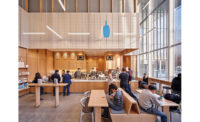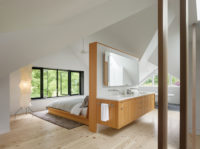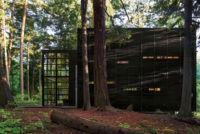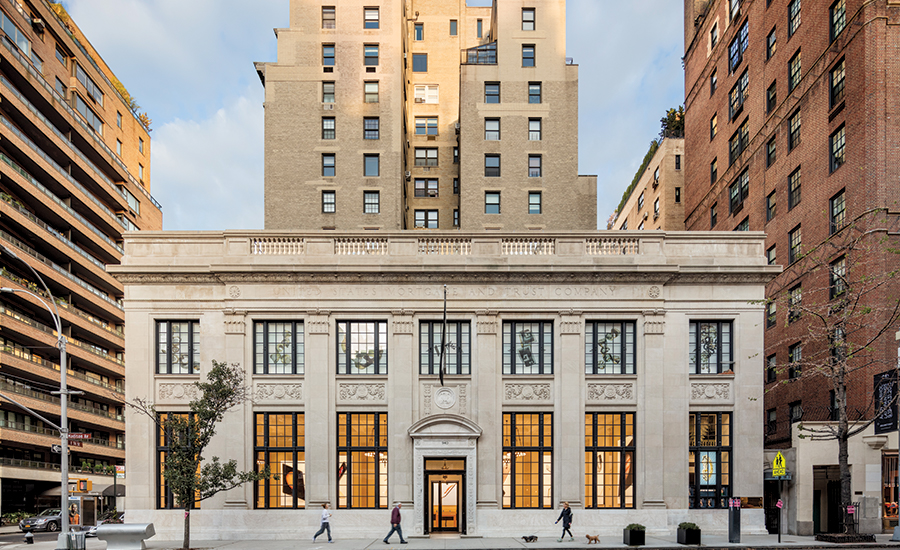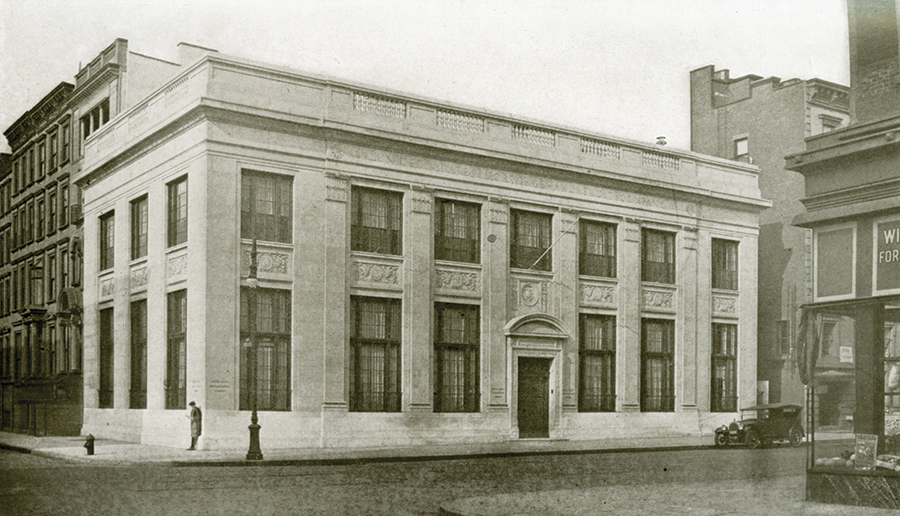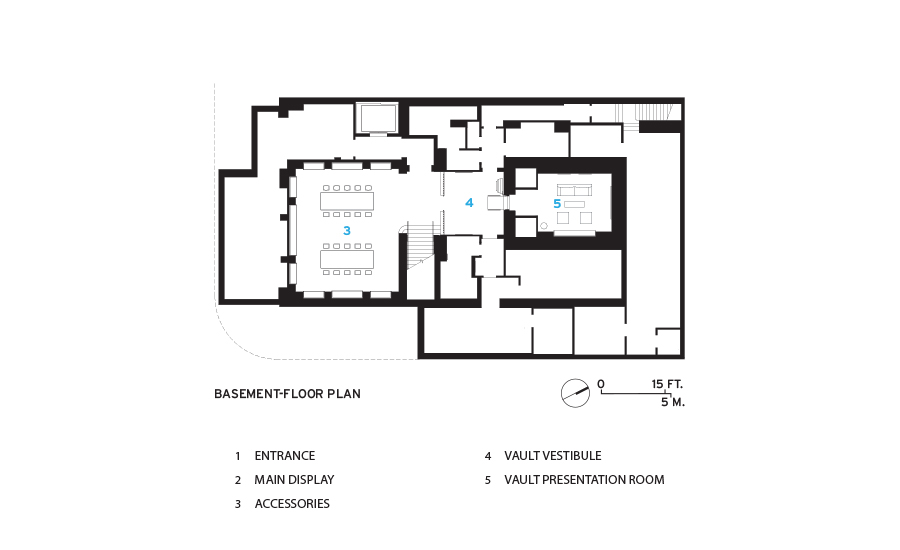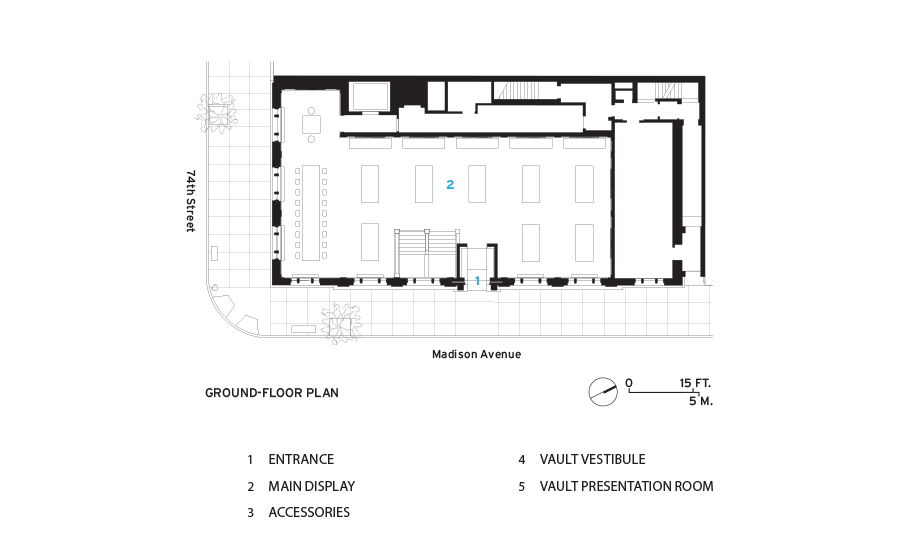Renovation, Restoration, Adaptation
Apple Store by Bohlin Cywinski Jackson
New York City

The classical-style bank building at 940 Madison Avenue in New York houses Apple’s revolutionary products. Its limestone exterior has been restored with such deportment it is hard to tell things have changed.
Photo © Peter Aaron / Esto

In February 1923, RECORD published photos of the classical-style bank building at 940 Madison Avenue in New York.

The original banking room in 1923.

The proportions and scale of Apple’s oak display tables replace check-writing stands and tellers’ windows.
Photo © Peter Aaron/ Esto

Working with dark spaces downstairs, the architects left the vault, separating it from the accessories room and lower lobby with the restored security screen.
Photo © Peter Aaron / Esto

They inserted shallow coffers and smaller circular chandeliers in the sales space.
Photo © Peter Aaron / Esto

Upstairs on the main floor the restored windows admit daylight on the east and south walls.
Photo © Peter Aaron / Esto

Image courtesy Bohlin Cywinski Jackson

Image courtesy Bohlin Cywinski Jackson









Architects & Firms
Apple’s latest store to open in New York is ultradiscreet. No large glass cube beckons passersby as it does on Fifth Avenue at 59th Street; no backlit Apple logo grabs your attention, as you find in its Grand Central Terminal location: the neighbors on the Upper East Side of Manhattan wouldn’t want either. Here, between the posh residential palaces of Fifth Avenue on the west and Park Avenue to the east, the Apple Store sits on Madison Avenue at 74th Street amid elegant shops, galleries, museums, and quiet hotels. In this enclave of restrained taste, you would sooner expect to see billionaires Michael Bloomberg, Stephen Schwartzman, or David Koch strolling past a window of Stubbs & Wootton slippers before you would a younger generation of with-it consumers trolling for the next iPhone.
The store is ensconced within a late English Renaissance-style two-story building designed in 1921 by Henry Otis Chapman of Barney & Chapman (RECORD, February 1923, page 143) as a branch of the United States Mortgage & Trust Company. As is frequently Apple’s policy with new stores, not only in New York but internationally, such as in Paris, Amsterdam, and Berlin, it seeks to retain the aura of an original structure while accommodating its famously future- oriented technological goods. For 940 Madison Avenue, the company again enlisted Bohlin Cywinski Jackson (BCJ)—the San Francisco and Philadelphia offices—as it had with four out of the five previous Manhattan outposts.
While the Apple emporia have proved to be great boons to their respective New York neighborhoods, this locale did not throw open its Armani-jacketed arms to greet the new arrival. Residents signed a petition last spring protesting the hot dog carts and crowds that might camp in front of the store. One property owner, Herbert Feinberg, filed a lawsuit that is still pending, arguing that, according to a fire protection consultant he hired, the new place may not be in compliance with fire codes. BCJ architects say they cannot comment because the case is in litigation.
Regardless of its chilly reception, Apple opened last June at its new location in the historic building, where the sales area totals 4,850 square feet, which the market director at Apple Retail, Jason Barlia, pointed out in a community hearing is a “boutique” about half the size of the Upper West Side store. “Apple’s gift is a real-estate team that finds unique buildings and places to put a store,” notes BCJ principal Karl Backus. To gain a foothold in this neighborhood, the company had to get approval of the proposed alterations for the building, which is in the Upper East Side Historic District, from the city’s Landmarks Preservation Commission. It has leased the main floor and the lower floor, formerly for the bank vault and storage; the top (second) floor remains in the hands of the ever-chic David Webb jewelers, which has its own entrance on the northeast corner of the building.
Working with CTS Group Architecture/Planning, BCJ cleaned, restored, and repaired the entire facade. The efforts included installing new glass and replacing muntins in the windows while keeping the mullions, and obtaining the right color and texture of Indiana limestone for requisite replacements for the exterior cladding.
The interior, however, needed to be completely overhauled. Throughout the years, the 1921 bank fittings and furnishings had been lost with various tenants that included a Chase branch, an antiques store, an art gallery, and most recently a luxury handbag and jewelry shop. The tellers’ windows and low marble balustrade dividers on the banking floor were long gone. So were the pilasters with shallow basrelief Corinthian capitals on the walls, along with the original chandeliers. But the latter two features BCJ and Apple decided to bring back: working with artisans, the design team not only recreated the pilasters and capitals but installed new wheel-shaped chandeliers mimicking the old. Although much of the coffered ceiling could be kept, it had to be repaired, and downlights and sprinklers inserted. Similarly the architects kept the grilles for heating vents and cloned new ones where needed. “It wasn’t just a deep clean,” says David Andreini, BCJ project director. “We had to adapt to the requirements of fire, universal access, and energy codes.”
To restore the stone floor, Apple sent the design team on seven trips to Italy match the Botticino marble. The process, explains Brigham Keehner, BCJ senior associate, required dry laying—mounting the marble on boards—at a fabricator before it was shipped to New York and installed. The typical Apple-designed stalwart oak display tables and shelving units also needed to be fine-tuned to the scale and proportions of the space.
Downstairs, the architects refurbished the old bank vault and its original door on the north end and fitted out the interior of the vault with a modern demonstration room. On the south end of the lower floor, BCJ inserted a new accessories area for ancillary Apple products, again with oak display tables and walls. In order to carve out a space from the original storage rooms, the architects removed columns and 18-inch-thick concrete bearing walls, and in turn beefed up overhead beams. In bestowing some of the 1921 architecture where it hadn’t really existed in this low basement space, BCJ created a coffered ceiling with new chandeliers, shallower and smaller than the ones upstairs.
The final result blends the old and the new in a manner befitting the demeanor of the neighborhood, and with an interior that is straightforward about its modern function but in a sympathetic relationship to its older trappings. A striking display of black-and-white photographs of the Upper East Side in the main salesroom unfortunately gave way to backlit panels of Apple products over the holidays, which sabotaged the soft lighting emanating from the chandeliers. Let’s hope that a more harmonious exhibition follows—as promised by Apple representatives on the floor.
Meanwhile, anecdotal observation indicates the crowds seem to be under control and have not spilled out onto the sidewalk (yet). Apple may have found a way to make itself beloved here: the company will receive the New York Landmarks Conservancy Chairman’s award in March for three Apple stores in traditional buildings—in Grand Central, in a former post office on Prince Street, and, even with neighborhood hesitance, 940 Madison Avenue.
PeopleArchitect: Bohlin Cywinski Jackson Bohlin Cywinski Jackson Personnel in architect's firm who should receive special credit: Karl A. Backus, AIA – Principal Associate Architects: CTS Group Architecture/Planning - David Abramson, principal Engineers: MEP: WSP Group (San Francisco, New York) Consultants: Lighting: ISP Design (Miami) Client:Apple Capital partnership
Size:10,730 square feet Cost:withheld Completion date:June 2015 General contractor:Shawmut Design and Construction (New York) Photographer:Peter Aaron, ESTO |
ProductsStructural system: Existing Steel Frame Exterior cladding Interior finishes Lighting Conveyance Add any additional building components or special equipment that made a significant contribution to this project: |


